Prospect Hill has a long history. It was a vantage point for the Norman army during their sustained attacks on the ancient town and fort of Galway between 1230 and 1235. The Bohermore Road leading through the area was known as the King’s Highway for a time. Eventually, both sides of the road were developed with houses and other buildings. A hospital dedicated to Saint Bridget was founded on Prospect Hill in 1543. In January 1596, the city came under attack from Red Hugh O’Donnell and his army from Ulster. This was during the Nine Year’s War. When his demand for supplies was refused, he took revenge by burning the eastern suburbs, including buildings on Prospect Hill. In 1710, the area was known as Knocknegany. Michael Logan’s Map of 1818 records the name as Cnoc Na Gainimhe (Sandpit Hill). In 1802, the County Infirmary opened on Prospect Hill. In February 1900, Michael Bodkin from Prospect Hill died of tuberculosis in the infirmary. He was the first love of Nora Barnacle and a plaque commemorating their affair was erected over the entrance to his home. It is now incorporated in Richardson’s off-licence near the corner of Eyre Square. Nora Barnacle later married the celebrated writer, James Joyce.
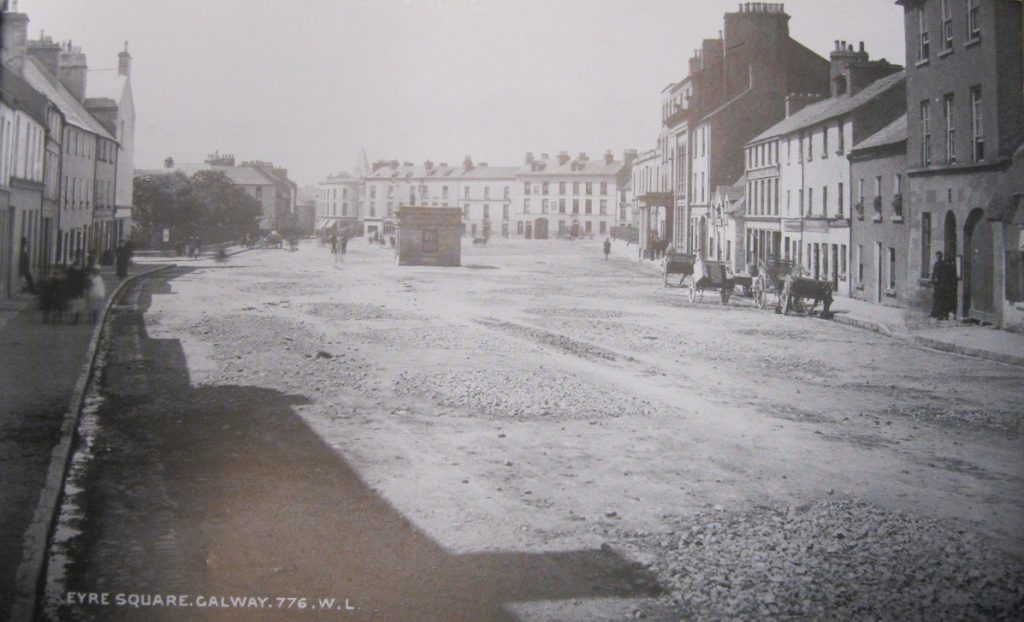
By 1924, the infirmary had been phased out. In 1926, Galway County Council began using the building as a library. Finally, in 1934, it became the County Buildings where much of the everyday business concerning the county was carried out. There is a children’s burial ground at the rear of County Hall in the northeast corner of the car park. This was where some of the babies who died in the infirmary were buried. The old infirmary was demolished in 1996 to make way for the new County Hall which opened in 1999. The facade of the infirmary was retained within the new building, but all of the internal structure was demolished. However, one feature was salvaged; the very attractive timber floor in the main bar of the Western Hotel is actually the floor of the infirmary. The Fleming family acquired the Western Hotel in 1945 and has continued to run a successful business since that time. Bernie married Joe Keville and the third generation of the family is running the business presently. Over the years the family have welcomed thousands of visitors to Galway and an indication of their hospitality is the fact that so many people return to stay with them year after year. This hospitality has always been extended to the locals also, and even today the ‘Western’ plays host to many functions and parties, providing good music and food.
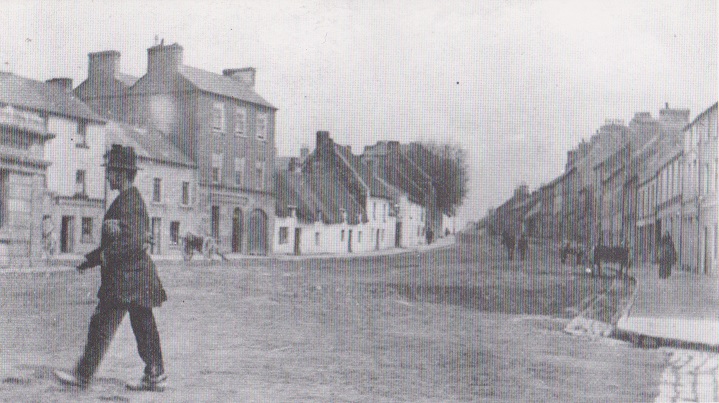
By the nineteenth century, two separate areas had evolved along the main road out of the city, Bohermore and Prospect Hill. According to some sources, Prospect Hill began at Eyre Square and finished at St Bridget’s Terrace or Water Lane, but this is sometimes disputed. Bohermore finished at Grealishtown. It is not known for certain when the name Prospect Hill was first used or how it was chosen. The name appears on the 1838 Ordnance Map of the area. The Western Hotel is one of three fine houses constructed during this period. One of these buildings was called Prospect House. An early occupant was Dr John MacEvilly, Bishop of Galway (1856-1881). In 1859, he sold Prospect House to the Jesuit order. The Jesuits remained there until 1863 when they built their new school and church at Sea Road. The question has often been asked was the house named after the area or was the hill named after the house?
A Market Weight House once stood in the centre of the road and the base of Prospect Hill. This was to accommodate the markets that were held regularly at Eyre Square. Many of the houses were thatched during this period. The Royal Irish Constabulary opened barracks on Prospect Hill in 1845. By 1883, it was the property of Lord Morris. He later rented the premises to Bartholomew Giblin, who later purchased the premises. He opened a bar and grocery business there. He also began renting rooms and this business later evolved into Giblin’s Hotel. The hotel was managed by Tom Giblin for many years during the twentieth century and was a very popular venue for weddings and other events. The site was later occupied by the Bentley, Cuba and is currently McGettigan’s Pub.
There were many other businesses located on Prospect Hill. A Mail Coach Office is recorded there in 1837. Thomas Lydon opened a successful bakery nearby in 1894 and the company was in existence until recent years. By 1855, Patrick Hughes had a forge on Prospect Hill. Thomas Hughes is recorded as the owner in 1864 and it continued in operation until at least 1899. Between the years 1839 and 1872, there was a Rope Walk in the area owned by James Forbes. This family gave their name to Forbes Lane during the period. Patrick Gleeson is recorded as the owner of the rope walks and yard in 1890. By 1899, it was under the ownership of James Flaherty. Forbes Lane is believed to have been beside the current Paddy’s Bar. In 1846, a woman named Eleanor Wheeler was also operating a rope manufacturing business in the area. Another Rope Walk existed at the top of Prospect Hill and was owned by Roger Lynskey. This business was lost because of the development of the Galway–Clifden Railway which opened in 1895. In 1846, William Coleman had a Cabinet manufacturing business. Michael Stokes was mentioned as owning a Coach Factory close by that same year. This had been converted to a dwelling house by 1859. In 1881, Hughes Coach Factory opened for business on Prospect Hill after moving from Whitehall. The business was registered as John B. Hughes and Company by 1891. Catherine Walsh had a Coach House and Livery Stable there in 1892. There was also a private school on Prospect Hill in 1868. The headcount consisted of twenty boys and twelve girls. Mary J. Hynes ran a Pipe Factory between 1880 and 1911. It is interesting that there is a large cross depicted on the 1651 Pictorial Map of Galway, which was known as ‘Mrs Hynes’ Monument’.
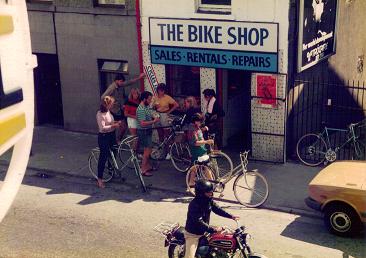
A new water supply for Galway was opened on Prospect Hill in 1868. These were two reservoirs and they supplied running water to the city for the first time in its history. The water was pumped up from the River Corrib, thus allowing gravity to supply water to the city below. The reservoirs were removed some forty years later to make way for the St Bridget’s Terrace housing scheme which began in 1910. Families began moving into the new houses two years later. The road running directly onto Hidden Valley where the reservoirs were located was called Pumpeen Lane.
A large four-story building known as St Patrick’s House stood at the top of Prospect Hill. It was purchased by the Sisters of Mercy in 1890 and converted into a domestic training centre for girls. However, the scheme failed because of a lack of funding and staffing problems. It is believed that Augustus John, the famous artist created some of his paintings there. The building was occupied by the nationalist movement by 1917 and became known as the Sinn Fein Hall. On 25 March 1921, the hall was attacked and burnt by the Black and Tans. The fire was so intense that houses on the opposite side of the road had to be evacuated and personal items and furniture removed. However, people from around the area organised a fire team and using buckets of water they managed to prevent the fire from spreading. The site was later occupied by Forde’s Garage and the Union Hall. These buildings were later demolished to make way for modern apartments and offices located on the site today.

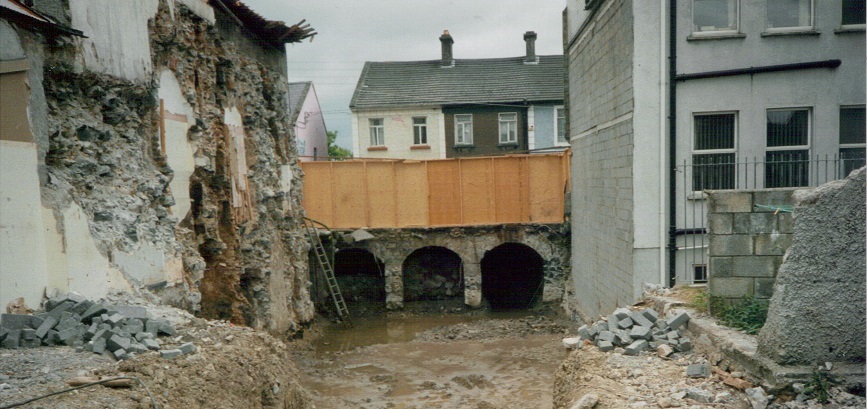

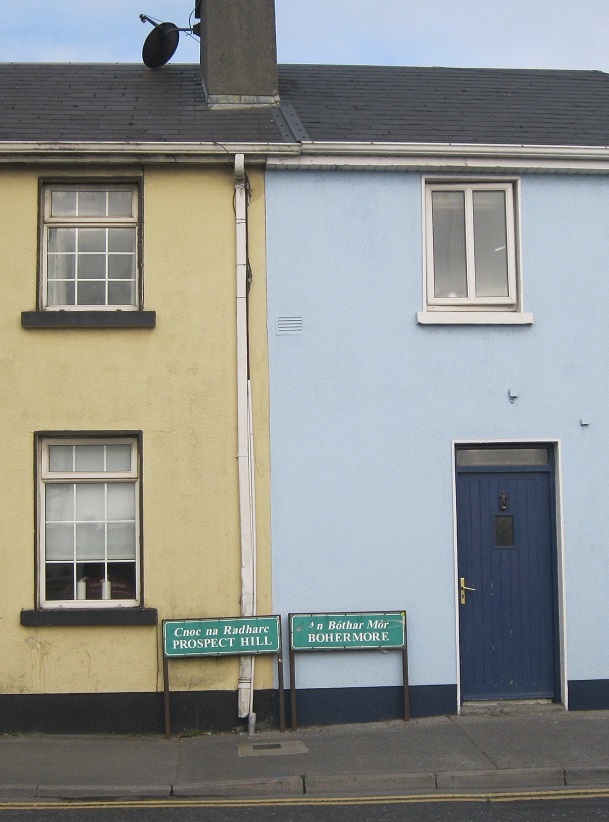
This is just a brief look at the history of Prospect Hill. Hopefully, this will generate greater interest and result in more information and photographs being made available.
I love this article and would like to know more about Prospect House, I vaguely remember a financial institute was situated there in the 1980-1990s? Do you remember their name?
Hi Jacqueline, we’re really glad you enjoyed the article and we’ve been racking our brains about the financial institution. We have a feeling it was a Building Society (just next door to where Paddy Powers is now) but we’re not quite sure which one. We’ll do an investigation and get back with an answer, hopefully :).
There was also Dalys rope walk which went from Ffrenchville to the turntable. They also made block & tackle.
When the railway came in it relocated to Parkmore/Twomileditch.
Do you know of any tobacconist shop in Prospect Hill opposite the County Buildings in the 1940’s. I am aware of Michael Bodkins shop which I think sold sweets. I ask as my father Jack Kirby “ ambushed “ my mother Mary Collins who worked in the Country Buildings , going to buy her cigs on her lunch break, resulting in marriage a year later in 1944. At the time , she was engaged to Shane McNally, brother of Des ( HD McNally builders ) who sadly drowned in the mid 1960’s along with Bill Forde from the Skeff in a boating accident near Oughterard.Perhaps it all happened in Bodkins . Thank you for your help. Best wishes John